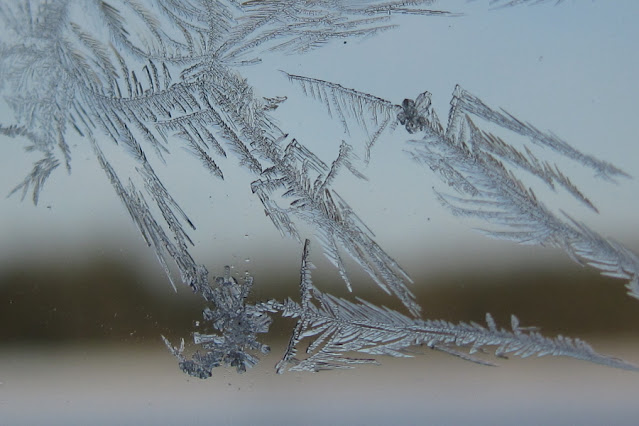 |
| Jack Frost's artwork adorns the windows. |
He most often shows his harder edges, but sometimes he relaxes a bit and shows his softer side with smooth, circular, swoops.
The very next night he walked along a small drainage that was still flowing with snow melt from the warm weather. Here he chilled the saturated soil enough that it froze at the surface and was forced to release its heat up into the cold air, growing more of the ice needles that he usually makes early in the season. With a plentiful supply of warm water and cold air, he made some pretty large needles.
 |
| Some of the larger ice needles I've seen. |
Another interesting ice formation was several weeks in the making, but it also has do with changing weather: Jack made us a lake-volcano.
I call these volcanoes because it appears a rock has erupted up out of the ice. But of course, the lake froze right after the water level was high due to the melting of three feet of snow, and when the water drained out, the ice dropped back down around the rock. A couple of weeks ago we had an earthquake; this week, a volcano.
I received a couple of enquires this week about all the holes in the snow with leaf debris scattered about them.
 |
| Who lives down there? |
These aren't actually homes, but are signs of red squirrels foraging down below the snow cover for something to eat. Looking carefully I could sometimes determine if they were successful in obtaining a meal, and if so, what they extracted. Here's a hole where it's pretty clear the squirrel came up with an acorn or two.
 |
| Acorn Scraps |
Other holes showed a lot of conifer debris thrown out of the hole, making me think the little guy was in search of hemlock or pine cones.
It's not obvious that our friend found anything to eat in this next one, but it certainly found oak leaves and a pine cone.
Why it didn't open the cone is unknow to me - did it know there were no developed seeds inside? Perhaps it was focused more on acorns as all the oak leaves suggest. Another question is how they know just where to dig. I can only assume they're able to smell oak or pine or hemlock aromas down below the snow - the rodent equivalent of following your nose to the bakery aisle at Moulton Farm.








No comments:
Post a Comment